- Table of Content
- 1.Great news fro...
- 2.Call for Solar...
- 3.European Space...
- 4.Postdoc positi...
- 5.Review of sola...
- 6.Review of geom...
- 7.PROBA2 Observa...
- 8.The Internatio...
- 9.Noticeable Sol...
- 10.Geomagnetic Ob...
- 11.The SIDC
- 12.Action!
2. Call for Solar Orbiter/EUI Guest Investigators
3. European Space Weather Week News
4. Postdoc position at ASTRON
5. Review of solar activity
6. Review of geomagnetic activity
7. PROBA2 Observations (23 May 2022 - 29 May 2022)
8. The International Sunspot Index by SILSO
9. Noticeable Solar Events (23 May 2022 - 29 May 2022)
10. Geomagnetic Observations in Belgium (23 May 2022 - 29 May 2022)
11. The SIDC
12. Action!
Great news from PROBA-3/ASPIICS!
ROB/SIDC has successfully passed the Flight Acceptance Review of its Science Operations Centre for PROBA-3/ASPIICS
PROBA-3 (https://www.sidc.be/proba-3/ ) is the next mission in the PROBA (PRoject for On-Board Autonomy) line of small satellites developed by the European Space Agency (ESA). It is primarily a mission dedicated to the in-flight demonstration of technologies for precise formation flying. For PROBA-3, this means that its two small spacecraft will be flying together in formation, along a highly elliptical orbit around the Earth. The formation of two spacecraft will produce a giant solar coronagraph called ASPIICS (https://www.sidc.be/proba-3/aspiics ), which stands for the Association of Spacecraft for Polarimetric and Imaging Investigation of the Corona of the Sun.
A coronagraph is a telescope that can observe the solar corona, the tenuous outer atmosphere of the Sun that is usually seen only under total solar eclipse conditions. During a total eclipse, the Moon completely covers the bright disc of the Sun, allowing the dim corona to be seen. The ASPIICS coronagraph will consist of two PROBA-3 spacecraft flying in formation, with one spacecraft carrying the optical telescope, and the second spacecraft carrying the circular occulter that plays the role of the Moon. The inter-spacecraft distance of around 145 metres will allow observing the corona close to the solar limb with unprecedentedly low parasitic light coming from the bright solar disc. Such conditions will be similar to those encountered during a total eclipse. In order to accomplish this task, the two spacecraft have to be aligned with the precision of a few millimetres.
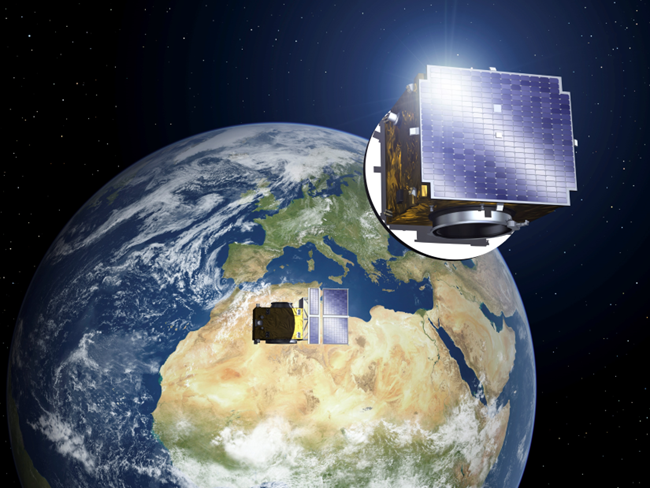
PROBA-3's pair of satellites (image credit: ESA - P. Carril, 2013)
PROBA-3, to be launched at the end of 2023, will not only demonstrate advanced technologies but is also a mission in the Science Programme of ESA. The scientific objectives of ASPIICS include the investigation of structure and dynamics of the quiescent solar corona and of coronal mass ejections (CMEs), huge eruptions of plasma and magnetic fields that may arrive at the Earth and produce geomagnetic storms.
Since 2017, the Solar Influences Data Analysis Center (SIDC - https://www.sidc.be/ ) of the Royal Observatory of Belgium (ROB) has been developing the Science Operations Centre (SOC) of ASPIICS. After the mission launch, the SOC will be tasked with creating observation programs for the desired science operations of ASPIICS, sending them to the PROBA-3 Mission Operations Centre in Redu (Belgium), as well as receiving and processing the acquired coronal images. The SOC is developed by a team of software engineers and scientists at SIDC, which has been supported by the SOC international partners from Germany, Italy, Poland, and Romania. An important aspect of the SOC is that it has to take into account the particular nature of this innovative mission, namely the presence of two precisely aligned spacecraft. The SOC will have to calculate the influence of dynamically changing positions and orientations of the two spacecraft on the resulting coronal images.
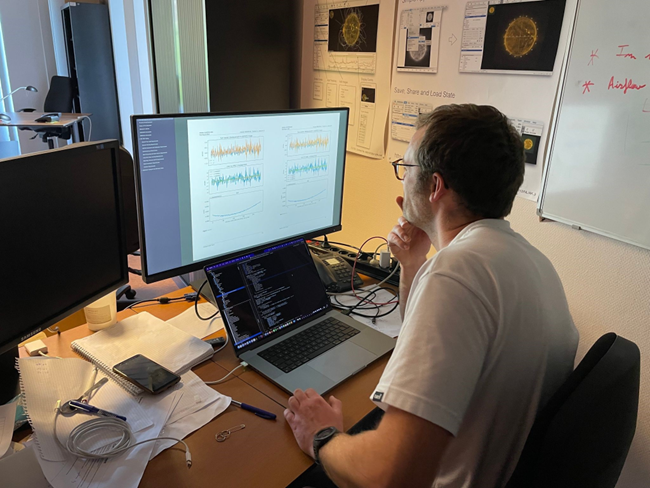
A committee consisting of experts in software development, space mission operations, and science was appointed by ESA to follow the SOC development and to review it at regular intervals. The Flight Acceptance Review was the last in the series of reviews. It had to certify that the SOC is built following the pre-defined scientific and technical requirements. The committee has thoroughly inspected the SOC software and associated documentation. In April 2022, it concluded that the SOC satisfies all the requirements and the Flight Acceptance Review of the ASPIICS SOC is successfully closed.
Call for Solar Orbiter/EUI Guest Investigators
The EUI PI team welcomes research proposals for the first round of its Guest Investigator Program for research based on EUI and Solar Orbiter data analysis by scientists outside the EUI PI team.
Selected proposers will be invited to spend a few weeks with the PI team at the Royal Observatory in Brussels to obtain expert knowledge on the instrument, to participate in the planning of observations according to the needs of their proposal, and to conduct their research. Each guest investigator will get reimbursed for travel, accommodation and living expenses.
Proposals must be received by November 1, 2022 (23:59 CET) and visits should be scheduled between January 2023 and January 2024. Details on the EUI Guest Investigator Program can be found here: https://www.sidc.be/EUI/GI_program.

European Space Weather Week News
Registration, abstract submission to a session, Topical Discussion Meeting submission are open!
Check: https://www.stce.be/esww2022/index.php

Postdoc position at ASTRON
ASTRON issued a call for application with regards to a postdoc position in ionospheric studies using radio astronomical data.
The selected candidate will perform independent research on ionospheric data obtained with the LOFAR radiotelescope.
The LOFAR radio telescope, although primarily designed for radio astronomical research, provides a vast amount of ionospheric information on short timescales and on small to medium spatial scales. Van de The behaviour of the ionosphere holds many open questions, and LOFAR can be transformative in our understanding of this. More research is needed to fully understand the wealth of information that can be obtained, utilizing various techniques as well as performing statistical analysis. Through LOFAR, as a supplier of ionospheric data, ASTRON is part of the Pithia-NRF consortium, a H2020 funded consortium that brings together many European institutes involved in research of the thermo- plasma- and ionosphere. As a postdoctoral researcher at ASTRON the selected candidate will be working on ionospheric data analysis in this international environment.
The deadline for the application is June 15th 2022.
All the details about this vacancy, including job requirements, employment conditions and application process: https://pithia-nrf.eu/news/postdoc-position-in-ionospheric-studies-using-radio-astronomical-data-at-astron

Review of solar activity
Flares
Solar flaring activity was overall at low level. The M1.3 flare on May 25 (peak time 18:24UTC) raised the level to moderate. Thirteen active regions were present. In particular, NOAA AR 3014 and 3017 maintained the most complex magnetic types and were the location of multiple, mainly on-limb, filament eruptions. NOAA AR 3013 which emerged on May 24, produced a C-class flare associated with a non-Earth directed Halo CME. CACTus sent out an automated alert for this CME. By the end of the week, all remaining active regions had obtained alpha magnetic type and the solar activity was very low.
Solar Wind Disturbances
Several filaments erupted, but none of the observed CMEs were Earth directed. A noteworthy event was a radio emission type II on May 28 15:58UTC at the time when solar activity was seen in the neighbourhood NOAA AR 3021. A dimming was detected via the Solar Demon tool and a coronal wave was visible.
Particles near Earth
The greater than 10 MeV proton flux was nominal.
The greater than 2MeV electron flux was just under the 1000 pfu threshold for most of the week, while being well below the threshold by the end of the week. The 24h electron fluence started from moderate levels while finishing the week nominal.
Review of geomagnetic activity
At the start of the week the solar wind speed was about 550 km/s and gradually decreased over the week reflecting a slow solar wind regime. From May 27 10:30UT the Co-rotating Interaction Region (CIR) of the negative polarity coronal hole which crossed the central meridian May 23 was apparent in the solar wind. Following the CIR, the solar wind speed increased to 600 km/s, Bz dropped to -16 nT and the total magnetic field values reached 18nT.
Geomagnetic conditions were quiet to unsettled, with minor storm conditions for a day from the CIR arrival (NOAA Kp, K Bel = 5).
PROBA2 Observations (23 May 2022 - 29 May 2022)
Solar Activity
Solar flare activity fluctuated from very low to moderate during the week.
In order to view the activity of this week in more detail, we suggest to go to the following website from which all the daily (normal and difference) movies can be accessed: https://proba2.oma.be/ssa
This page also lists the recorded flaring events.
A weekly overview movie can be found here (SWAP week 635): https://proba2.sidc.be/swap/data/mpg/movies/weekly_movies/weekly_movie_2022_05_23.mp4
Details about some of this week's events can be found further below.
If any of the linked movies are unavailable they can be found in the P2SC movie repository here: https://proba2.oma.be/swap/data/mpg/movies/
Wednesday May 25
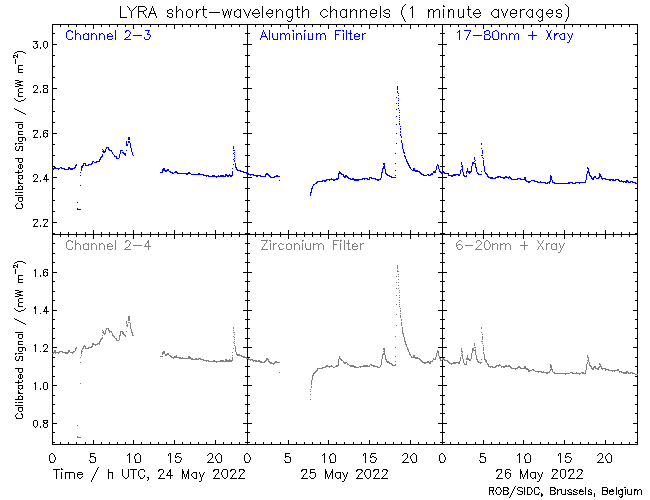
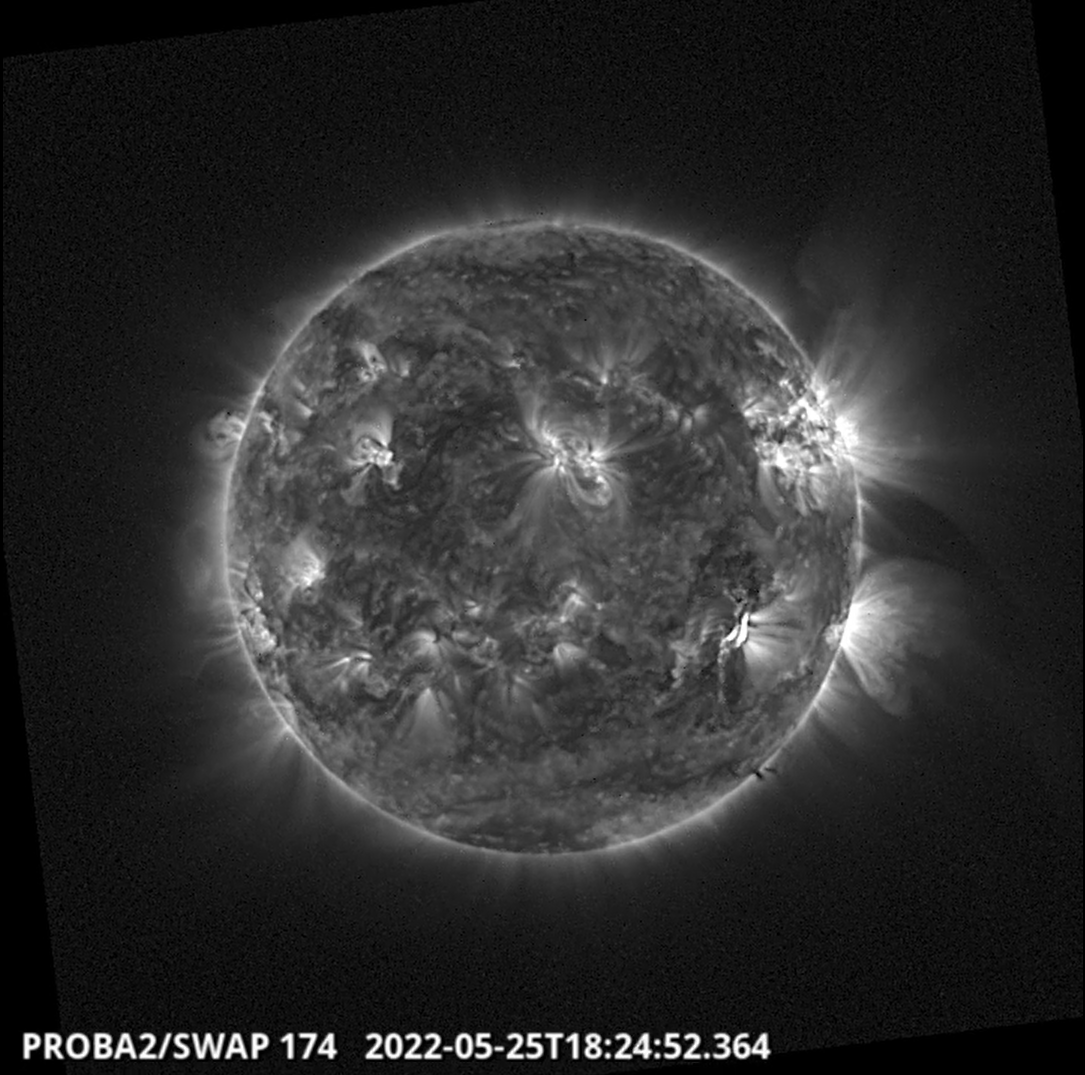
The largest flare of the week, an M1.3 flare, was observed by SWAP and LYRA. The flare was associated with NOAA AR3016 and is visible in the south-west quadrant on 2022-May-25, as shown in the SWAP image above taken at 18:24 UT.
Find a movie of the event here (SWAP movie): https://proba2.sidc.be/swap/movies/20220525_swap_movie.mp4
The International Sunspot Index by SILSO
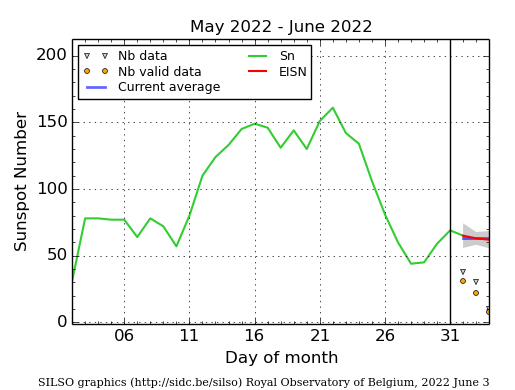
The daily Estimated International Sunspot Number (EISN, red curve with shaded error) derived by a simplified method from real-time data from the worldwide SILSO network. It extends the official Sunspot Number from the full processing of the preceding month (green line), a few days more than one solar rotation. The horizontal blue line shows the current monthly average. The yellow dots gives the number of stations that provided valid data. Valid data are used to calculate the EISN. The triangle gives the number of stations providing data. When a triangle and a yellow dot coincide, it means that all the data is used to calculate the EISN of that day.
Noticeable Solar Events (23 May 2022 - 29 May 2022)
| DAY | BEGIN | MAX | END | LOC | XRAY | OP | 10CM | TYPE | Cat | NOAA |
| 25 | 1809 | 1824 | 1843 | S19W41 | M1.3 | 1N | 160 | III/2II/3IV/1 | 16 | 3016 |
| LOC: approximate heliographic location | TYPE: radio burst type |
| XRAY: X-ray flare class | Cat: Catania sunspot group number |
| OP: optical flare class | NOAA: NOAA active region number |
| 10CM: peak 10 cm radio flux |
Geomagnetic Observations in Belgium (23 May 2022 - 29 May 2022)

Local K-type magnetic activity index for Belgium based on data from Dourbes (DOU) and Manhay (MAB). Comparing the data from both measurement stations allows to reliably remove outliers from the magnetic data. At the same time the operational service availability is improved: whenever data from one observatory is not available, the single-station index obtained from the other can be used as a fallback system.
Both the two-station index and the single station indices are available here: http://ionosphere.meteo.be/geomagnetism/K_BEL/
The SIDC
The forecaster on duty presented the space weather overview from May 22 to 29.
The pdf and movie can be found in: https://www.stce.be/briefings/20220530/
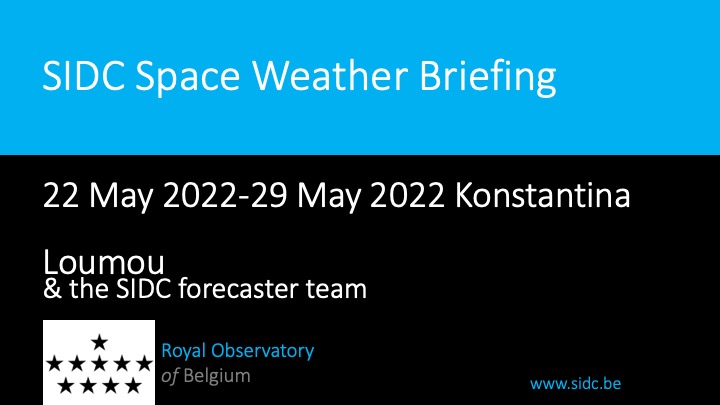
Action!
Check out our activity calendar: activities and encounters with the Sun-Space-Earth system and Space Weather as the main theme. We provide occasions to get submerged in our world through educational, informative and instructive activities.
If you want your event in our calendar, contact us: stce_coordination at stce.be
* June 9, Public Lecture, Noorderlicht - hemelse wetenschap, Molenhof, Leuven, Belgium
* June 9, KU Leuven CmPA Seminar: Simulations of flux emergence events, Leuven, Belgium
* June 13-15, Space Weather Introductory Course - onsite, by the STCE, Brussels, Belgium
* June 21, First Innovation day of PITHIA-NRF, Rome, Italy
* June 23, KU Leuven CmPA Seminar: COOLFluiD - High-Order Methods for Transitional Hypersonic Flow Modelling, Leuven, Belgium
* June 25, STCE at the Summer Space Festival, Brussels, Belgium
* July 3, Public Lecture on STCE's mission to the Sun, Cosmodrome, Genk, Belgium
* August 25, Public Lecture on Space Weather and Aviation, Astropolis, Oostende, Belgium
* October 24-28, 18th European Space Weather Week, Zagreb, Croatia
* November 21-23, Space Weather Introductory Course - onsite, by the STCE, Brussels, Belgium
* December 5, 6, 8, 9, Space Weather Introductory Course - online, by the STCE, zoom
Check: https://www.stce.be/calendar
